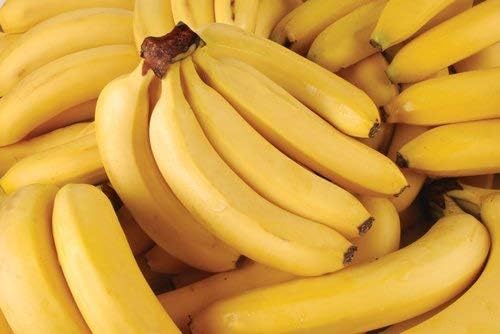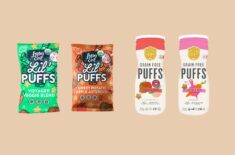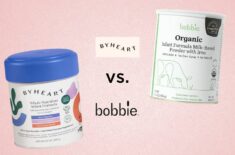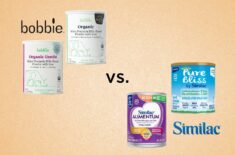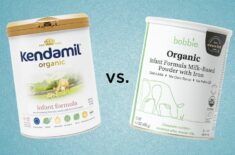Overview
Bananas are among the popular first foods for babies. They’re packed with nutrients, can be easy to prepare, and aren’t considered a common choking hazard.
Plus, many moms love how they can easily pack bananas in their bag for their baby’s snack on the go.
If your little one is hungry, you can simply hand them banana slices to munch on.
But if you’re new to baby-led weaning, you might be wondering how you can cut bananas for self-feeding.
You might also want to know at what age you can give bananas to your baby, whether it’s an allergen, and if they can cause constipation.
Are you looking for baby food recipes with bananas? Should you steam bananas? How ripe should bananas be for baby-led weaning? Find answers to these questions below.
What’s Baby-Led Weaning?
Baby-led weaning or BLW is a feeding approach that lets your child take control of their mealtimes. You don’t help them out, even if it’s their first time eating solid foods.
BLW promotes independence and healthy eating habits. You might raise a foodie instead of a picky eater with baby-led weaning. (1)
Learn more about this feeding approach in our BLWguide.
Top Reasons To Serve Banana For Baby-Led Weaning
Nutrition Facts
Bananas are listed on the Dietary Guidelines for Americans (2020-2025) as one of the recommended nutrient-dense foods to eat for all ages. (2)
Because they’re nutritious, the American Medical Association also considers bananas “superfoods.” (3)
Indeed, bananas can be among the best first foods for your baby because they’re rich in the following nutrients:
- Vitamin B6
- Vitamin C
- Potassium
- Magnesium
- Manganese
- Dietary fiber
One serving (one medium-sized ripe banana) can provide your baby with the following: (3)
- Calories: 110 calories
- Fats: 0 g
- Proteins: 1 g
- Carbohydrate: 28 g
- Naturally occurring sugar: 15 g
- Fiber: 3 g
- Potassium: 450 mg
Potassium is an important mineral our bodies need for many functions, including: (3)
- Proper muscle contraction
- Healthy water balance and waste removal in cells
- Maintain normal heartbeat and a healthy blood pressure
Other Benefits
- Bananas don’t require cooking and can be easily cut even without a knife.
- Because they have a thick peel that’s easy to open with your hands, you can simply put some bananas in your bag for your baby’s snack on the go.
- You can use bananas for different recipes, but they can also be served raw (with or without spices and toppings).
When Can Babies Eat Bananas?
Bananas are packed with nutrients and are soft enough to be among the best first foods for your baby. You can introduce your child to bananas once they’re ready for solid foods.
The AAP (American Academy of Pediatrics) and the Dietary Guidelines for Americans recommend introducing your child to solid foods only when they’re at least six months old. (4)
But some babies might already be ready by four months of age.
Many pediatricians and health professionals recommend checking for signs of readiness instead of using age to determine when to start giving solids.
Your child should meet all these signs of readiness before you can consider them as ready for their first solid foods: (4)
- Can already sit up (with or without support)
- Can control their head and neck
- Brings objects to their mouth
- Opens their mouth when they’re offered food
- Swallows food instead of pushing it out with their tongue (called the tongue-thrust reflex)
- Tries to grasp small objects, including food or toys
- Shows physical ability to swallow (can transfer food to the back of their mouth)
But be sure to ask your child’s pediatrician or a health professional before feeding your child any solid food, especially if they’re below six months of age.
Can I Give My Three-Month-Old Mashed Banana?
No. Introducing food before your child is four months old isn’t recommended. (4)
Although mashed bananas can be softer than plain uncut fruit, they’re still considered solid foods. If your child isn’t ready for solids, giving them some can be dangerous. (5)
Can Four-Month-Old Babies Eat Bananas?
Yes, but only if they’re ready for solid foods.
Baby-led weaning pioneer Dr. Gill Rapley recommends waiting until your child is six months old before you give them solid foods for the first time. But she also acknowledges that some babies develop early and can start at four months. (5)
Check with your child’s pediatrician whether it’s safe for your baby to start solid foods, especially if they’re below the recommended age of six years old and above.
Can I Give My Six-Month-Old A Banana?
Yes, as long as they show the signs of readiness listed above.
Bananas can be a nutritious food to give a baby eating solid food for the first time. It’s soft, so it’s not considered a common choking risk.
But if you’re following the BLW approach, it’s important to determine whether your child is truly ready for solids.
Your child feeds themselves and determines how much they eat in BLW. They also eat at the pace they choose. So, they must already know how to pick food up and swallow it.
Even if your child is already six months old, be sure to get a go-signal from your pediatrician to give them solid foods if you’re unsure about their readiness.
Some babies, such as those born prematurely, might develop more slowly than others. They might not be ready for solid foods at this age.
But they can catch up and might be ready when they’re around six months from their due date, not their birth date.
How Do I Introduce Banana To My Six-Month-Old?
If your baby is ready for bananas when they turn six months old, you can give them a few slices of bananas to try.
Babies use their palmar grasp (using all their fingers to grab food) at this age.
So, the cuts should be large enough (around 2-3 inches) to hold in their palm, but they still have something left at the top for them to munch on.
For their first time trying to eat bananas, it can be a good idea to keep it simple. Give it to them as raw fruit slices.
You can also add some hemp seeds for texture and to help keep the fruit from being too slippery.
How Much Banana Can My Baby Eat Per Day?
Babies can have different appetites and food preferences. But they might eat the following, according to their age:
- 6 – 9 months old: ⅓ medium banana per day
- 9 – 12 months old: ½ medium banana per day
- 12+ months old: 1½ medium banana
How Much Banana Can A Four-Month-Old Baby Eat?
If you’re following traditional weaning, your child might start on around ½ to 1 tsp of banana purée and gradually increase to 6 tbsp in their first month on solid foods.
But if you’re doing baby-led weaning, then there’s really no telling how much your child will eat.
BLW babies choose the foods they want from the ones you prepared, and have their fill. But it can be hard to predict whether they’ll eat all the food you prepared or refuse to pick it up.
It can also be difficult to measure how much food they can eat.
One way to avoid wasting a lot of food in BLW is to only put a few pieces on their plate or food tray. Just monitor what they like eating and add more if they still want the same food.
But be sure to ask your child’s pediatrician or a health professional before feeding your child any solid food, especially if they’re below six months of age.
How Much Banana Can A Five-Month-Old Eat?
Again, it’s hard to tell how much a baby eats in baby-led weaning. But it might be unlikely that they can eat a whole banana, even a small one, at this age.
Still, it can be a good idea to use one banana to prepare their meal. You need to give your baby longer slices for safety and practicality. It can help ensure they won’t accidentally swallow the entire piece at once, leading to choking.
Also, longer cuts can be easier for them to grasp with their palm, then eat from the portion that sticks out from their hand.
How Do You Serve Bananas For Baby-Led Weaning?
There are different ways to serve bananas in BLW. You can try them all to see which ones your baby might like best.
Some examples can include the following:
- Handheld banana (with peel at the bottom)
- Little spears or slices without toppings
- Cut into cubes or small pieces
- Small pieces of homemade banana muffins
- Mashed
- Slices with peanut butter, hemp seeds, or other toppings
- Slices of banana pancakes
- Smooth purée
Although purées are often associated with traditional weaning, you can also introduce them in baby-led weaning.
Here are some ways to use purées in BLW:
- Put two to three spoonfuls of purée in your child’s bowl. Let them dip their fingers in and taste the purée from their fingers.
- Show them how to use the purée as a dip for their baby food.
- Put pre-filled spoons on their food tray and let them pick one that they can try putting in their mouth.
You can use bananas mixed with breast milk or formula to prepare homemade baby purées. Some parents also find yogurt useful, though you should check with your doctor before using this ingredient if your child has food allergies. You can also use coconut yogurt.
Aside from adding hemp seeds or peanut butter (not too thick or chunky) to your banana slices, you can also let your child try some spices, but hold the salt:
Peanuts are a common allergen. But experts now recommend the early introduction to peanuts and other common allergens to help prevent your child from developing allergies. (2)
Still, talk to your pediatrician before introducing your child to any allergenic foods, especially if they have known allergies.
Preparing Bananas For Baby Led Weaning
Should I Steam Banana For Baby?
No. Bananas are soft enough for your child to eat raw.
Just make sure you choose ripe bananas.
Cooking (steaming, roasting, baking, or boiling) is recommended for hard fruits and veggies like apples and carrots. It can help make them soft enough for your child to eat and reduce the risk of choking.
How Ripe Should Banana Be For Baby Led Weaning?
Bananas should be ripe enough to be soft and easier to eat. Try to choose a fully yellow banana that separates easily from the stem.
Unripe bananas can be hard and cause constipation in babies.
If you purchased unripe bananas (still a little green), you can place them in a paper bag along with an apple or ripe banana to help speed up ripening.
Overripe bananas can be too soft and mushy for your child to hold as finger food in BLW. But you don’t have to discard overripe bananas even if the peel turns brown or black, as long as the inside is still unspoiled.
How Do You Cut Bananas For A Baby?
Bananas can be one of the easiest homemade baby foods to prepare. You won’t even need a knife to cut it.
Many parents find it easy to simply hand a half-peeled banana to their children.
You can trim off around 2 inches from the upper part of the peel, then leave the rest for an easy-to-grip handle at the bottom. Peel off more if your kid still wants to eat.
If you want to serve it without a peel, you can also cut the fruit. Here are some suggestions on how to cut them according to your child’s age:
For 4-9 months:
- Cut a banana into small spears or slices (2-3 inches) about the size of your fingers. It can help make it easier for your baby to grab one.
- Bananas can be slippery. You can add toppings like peanut butter, gluten-free bread crumbs, or hemp seeds for more texture. These toppings can also help make the banana slices easier to hold.
For 9-12 months:
- You can cut a banana into thin strips or small cubes for this age group. Add some bread crumbs, hemp seeds, peanut butter, spices, or other toppings for flavor and texture.
For one year and above
- Most babies may have already mastered the pincer grasp at this age. So, it can be easier for them to pick up small pieces with their thumb and index finger.
- You can cut a banana into smaller pieces or medium-sized chunks. But because bananas can be slippery, check if your child is having a hard time picking up the pieces. Adjust accordingly.
- Your kid can also learn how to peel a banana on their own at this age.
Although bananas aren’t a common choking hazard, it’s best to watch your child during mealtimes to avoid accidents.
Also, talk to your pediatrician before introducing your child to any allergenic foods, especially if they have known allergies.
Can I Give Baby A Whole Banana?
Yes, but make sure that you monitor your child closely because they can bite off a huge chunk of the banana, creating a choking hazard.
Frozen Bananas For Your Teething Baby
Frozen bananas can be great for your baby’s teething pains.
You can make frozen popsicles from banana purée or freeze a sliced banana.
These can help your baby soothe their sore gums with something they might also enjoy as a tasty treat.
Food Safety With Banana For Baby-Led Weaning
Choking
Bananas are soft and can be easily chewed even by babies who don’t have teeth. These fruits aren’t considered a choking hazard. It might be among the reasons why many parents pick it as one of their baby’s first foods.
But it’s still important to remember that any solid foods can be a potential choking hazard.
So, it’s always a good idea to cut bananas into appropriate sizes for your child’s age. You can follow our suggestions on how to cut bananas mentioned above.
To avoid choking risks, follow this rule of thumb for bananas and other baby foods:
- It shouldn’t be too hard for a toothless baby to chew.
- It shouldn’t be too easy for a child to swallow whole accidentally.
Is Banana A High Allergy Food?
Bananas aren’t among the most common food allergens. However, though it’s rare, some people might be allergic to bananas. (6)
Banana allergy may often occur along with other allergies:
- Latex allergy
- Pollen food allergy syndrome
Latex Allergy
People with latex allergies can react to bananas because of the similarities in the allergenic proteins in both. (6)
Pollen Food Allergy Syndrome
People who suffer from hay fever or are allergic to pollen can also react to bananas due to similarities in their protein structures. (6)
Those with banana allergies can also react to other fruits or veggies that contain similar proteins: (6)
- Plantains
- Kiwi
- Avocado
- Chestnut
- Peach
- Olive
- Tomatoes
- Carrots
- Bell peppers
Most cases of banana allergy may not be severe. (6)
But if you notice that your child might have a banana allergy, it’s best to consult with their doctor for help in managing their allergies.
How Do I Know If My Baby Is Allergic To Bananas?
Banana allergy is considered an oral allergy syndrome because its symptoms usually affect just the mouth or throat. (6)
Allergic reactions can vary, but symptoms usually develop within a few seconds or minutes of eating bananas.
Symptoms of a mild reaction can include the following:
- Itchy mouth and/or throat
- Itchy rash (hives or urticaria)
- Stuffy or runny nose
- Local swelling (lips and mouth)
- Gas
- Diarrhea
- Vomiting
Severe symptoms of a banana allergy can include these:
- Narrowing of the throat
- Wheezing
- Difficulty breathing
- Collapse
A severe allergy to bananas can cause anaphylaxis in extremely rare cases. Immediately call emergency services if you notice your child having these reactions to bananas or any food they’ve eaten.
Although severe cases can happen, banana allergy may be categorized as mild.
According to the Anaphylaxis Campaign, the proteins that cause banana allergies are unstable. So, they might not cause a severe allergic reaction. (6)
Though they can affect your child’s mouth and throat, these proteins are destroyed once they reach the stomach. (6)
But if your child has a high risk of being severely allergic to bananas, their pediatrician might prescribe an epinephrine auto-injector.
Easy Banana Recipes To Try
Banana Strips With Hemp Seeds
Ingredients
- One ripe banana
- 1 tsp hemp seeds
Preparation Instructions
- Peel the banana.
- Cut it into age-appropriate slices.
- Sprinkle with hemp seeds before serving.
You can also try gluten-free bread crumbs or spices like cumin and cinnamon instead of hemp seeds.
Toast with Banana Toppings
Ingredients
- One slice of gluten-free bread
- One ripe banana
Preparation Instructions
- Peel the banana.
- Mash it lightly.
- Put the mashed banana on the bread.
- Toast for a few minutes.
- Slice into strips.
- Cool before offering the toast to your baby.
You can try other fun toppings to your baby’s toast, including avocado, sweet potato, eggs, and nut butter (not chunky or too sticky).
REFERENCES
(1) http://www.rapleyweaning.com/assets/Defining_BLW_v2.pdf
(2) https://www.dietaryguidelines.gov/sites/default/files/2020-12/Dietary_Guidelines_for_Americans_2020-2025.pdf
(3) https://www.hsph.harvard.edu/nutritionsource/food-features/bananas/
(4) https://www.cdc.gov/nutrition/infantandtoddlernutrition/foods-and-drinks/when-to-introduce-solid-foods.html
(5) http://www.rapleyweaning.com/assets/How_early_is_too_early.pdf
(6) https://www.anaphylaxis.org.uk/knowledgebase/banana-allergy/



